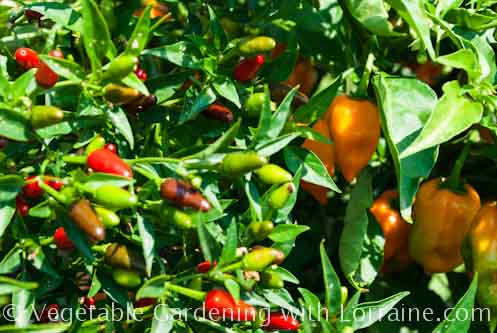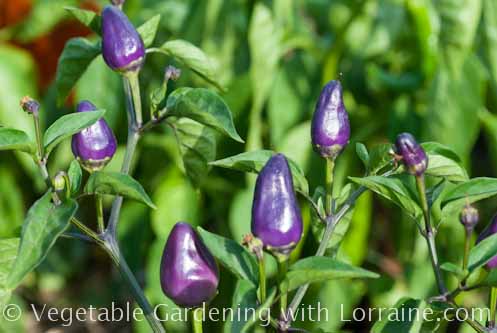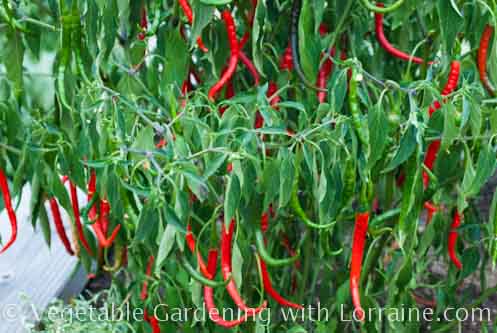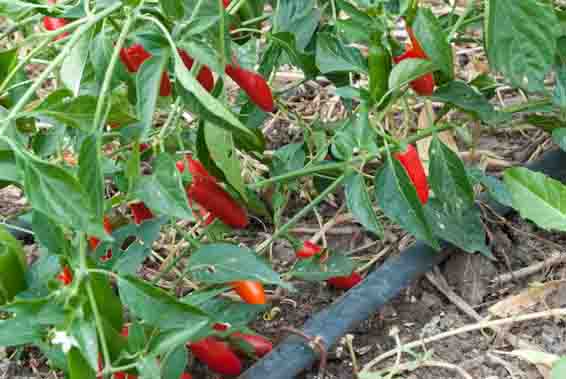- Home
- How to Grow Vegetables A-Z
- Growing Hot Peppers
Growing Hot Peppers
Adventures in Flavor
From the mild Pimiento to the nuclear Trinidad Moruga Scorpion, growing hot peppers is an adventure in flavor. One of the easiest crops to grow, hot peppers thrive in containers as well as in the backyard vegetable garden. (To skip straight to the Hot Pepper Chart, click here.)
Even among people who aren't into vegetable gardening, growing hot peppers is hugely popular. Many cooks fall into this category, because having a wonderful variety of such intense flavors at your fingertips makes the small effort involved well worth it.
And in case you're wondering, "hot pepper" means the same thing as "chili pepper", just two ways of referring to the same HOT little pods.
For general pepper growing guidelines, including seed-starting, growing conditions, and diseases, see Growing Peppers. This page focuses on the specifics of HOT peppers.
 Thai and Habanero Peppers Thai and Habanero Peppers |
 Purple Super Hot Peppers Purple Super Hot Peppers |
 Cayenne Peppers Cayenne Peppers |
 Ripe Red Jalapeno Peppers Ripe Red Jalapeno Peppers |
Growing Hot Peppers: A Favorite Since 7500 BC
7500 BC Native peoples of Central and South America domesticate and cultivate wild peppers
1493 first peppers arrive in Europe on Columbus' return trip
1500s more varieties arrive in Europe with Spanish friars returning from the New World, and they spread throughout Europe from Portugal and Spain. The Portuguese spread them along their trade routes from Brazil to Africa and India. At one time in the 1500s hot peppers were outlawed in Portugal because they threatened the lucrative black pepper trade.
1600-1700s From India they spread to Indonesia, New Guinea and Malaysia, and up throughout Asia. The loop is completed when the Turks carry them to Hungary and across Eastern Europe.
Late 1700s The noble capsicum finally makes its way to North America with European settlers (not from Mexico or South America!). It seems that North America was last populated place on earth to incorporate peppers into its cuisine.
Five Species, Hundreds of Varieties of Chili Peppers
Capsicum annuum is the most cultivated species, originally from Mexico. Most chili pepper and bell pepper varieties belong to this species. These plants are “annuals” in regions of frost. Where it never freezes the plants are perennial.
Capsicum pubescens is native to Central and South America and in Peru, and is called “rocoto”. Its species name refers to the fact that the leaves of the plant are somewhat fuzzy rather than smooth. It’s pretty rare to find these outside of the Andes, but it is grown there because it can grow there, in the cooler, higher regions where other peppers shiver to death. The varieties are very hot.
Capsicum baccatum is widely used in Peruvian, Bolivian, and Paraguayan cuisine. These peppers are orange when ripe and often have a little “crown” around the top. I’ve heard it said that these came from the Old World to the New rather than the other way around, but I have not found evidence of this. Common varieties are the aji amarillo (amarillo chili), the aji limon (with a citrus-like flavor) and the sweet, often pickled peppadew.
Capsicum chinense also known as “yellow lantern chilis” because many varieties resemble little lanterns. The super-hot habañero belongs to this species, and is native to Central America, the Yucatan and the Caribbean.
Capsicum frutescens originally from the hot humid climates of Amazon, Central America and the Caribbean, peppers of this species are both hot and sweet at the same time. Now popular in Ethiopian and other African cuisines.
How Hot is Hot: The Scoville Heat Units Scale
What makes hot peppers hot is capsaicin, a substance that irritates human skin and mucous membranes. Back before we had liquid chromatography to measure exact amounts of chemicals in substances, it was necessary to employ human tasters to determine how “hot” a pepper was.
To decrease the possibility of subjective variance, a pharmacist named William Scoville devised a test where the juice of the various peppers was repeatedly diluted down to the point where the “heat” finally became undetectable by a 5 person panel.
This resulted in the “Scoville Heat Units Scale”, which rates peppers along a scale from 0 to 16,000,000 SHUs. Pure capsaicin is 16,000,000 SHU (sixteen million). The hottest pepper ever measured on planet earth was 2,009,231 SHUs (two million-ish). A sweet bell pepper with no heat is 0 SHUs.
Scoville Heat Units Hot Pepper Chart
| Variety | Scoville Heat Units |
| Sweet Bell Pepper | 0 |
| Banana Pepper | 0-100 |
| Pimento | 100-500 |
| Pasilla | 250-3,999 |
| Paprika | 250-1,000 |
| Anaheim | 500-1,000 |
| Poblano (fresh) = Ancho (dried) | 1,000-2,000 |
| Hatch chilies (most) | 1,000-2,000 |
| Aji amarilla | 1,177-25,000 |
| New Mex Big Jim | 2,500-3,000 |
| Jalapeño | 2,500-8,000 |
| Chipotle | 2,500-8,000 |
| Fresno | 2,500-10,000 |
| Hungarian Wax | 5,000-15,000 |
| Serrano | 5,000-15,000 |
| Aji limon | 30,000-50,000 |
| Tabasco | 30,000-50,000 |
| Cayenne | 30,000-50,000 |
| Rocoto | 30,000-100,000 |
| Thai | 50,000-100,000 |
| Red Amazon | 75,000 |
| Jamaican Hot | 100,000-200,000 |
| Scotch Bonnet | 100,000-350,000 |
| Habañero | 100,000-350,000 |
| Fatalii | 125,000-325,000 |
| Trinidad Scorpion | 300,000+ |
| Chocolate Habanero | 300,000-475,000 |
| Naga or Bhut Jalokia (Ghost) | 1,001,304 |
| Naga Viper | 1,382,118 |
| Dorset Naga | 1,000,000-1,500,000 |
| Trinidad Moruga Scorpion | 2,009,231 |
Addiction to Hot Peppers (and Addiction to Growing Hot Peppers!)
As anyone who eats hot peppers on a regular basis can tell you, it’s a slippery slope between jalapeños and habañeros or beyond, and one can start to feel deprived, maybe even uncomfortable, without hotsauce within reach!
Addiction is not always an easy thing to define, but addictions tend to have the following things in common:
- Neural changes in the brain: the pathways used become both well-established and desensitized
- Tolerance: it takes more and more to reach the same satisfaction level over time
- Withdrawal: craving occurs when deprived
- Preoccupation: social and recreational activities can begin to revolve around the substance or behavior
So it is actually true that hot peppers are addictive! But that’s a good thing in this case, because hot peppers are really good for you. They aid digestion, provide loads of antioxidants and vitamins, improve circulation and help alkalize the body.
But it is also now known that the seeds, membranes and skin are high in inflammatory lectins. But if you fire roast peppers and peel the skin & toss the seeds, you remove most of the lectins and are left with mostly flavor.
And as those of us who are into growing hot peppers know, every year we need to grow more and more varieties, and feel deprived if we don’t, so addiction to growing hot peppers is also true!
Growing Chile Peppers in Containers
Peppers are one of the easiest and most fun thing to grow in pots and other containers on a patio or balcony. The plants don’t get overly large, and when they start to bear fruit (yes, the peppers are technically a fruit) they can be stunningly beautiful, in different shades of green, purples, yellows, oranges and reds. See the Container Vegetable Gardening article for details of successfully growing hot peppers in containers.
Hot peppers also grow really well in upside down planters hanging from sunny eaves. Just follow the same directions given on Growing Upside Down Tomatoes.
Help share the skills and spread the joy
of organic, nutrient-dense vegetable gardening, and please...
~ Like us on Facebook ~
Thank you... and have fun in your garden!
Affiliate Disclaimer
This website contains affiliate links to a few quality products I can genuinely recommend. I am here to serve you, not to sell you, and I do not write reviews for income or recommend anything I would not use myself. If you make a purchase using an affiliate link here, I may earn a commission but this will not affect your price. My participation in these programs allows me to earn money that helps support this site. If you have comments, questions or concerns about the affiliate or advertising programs, please Contact Me.Contact Us Page



